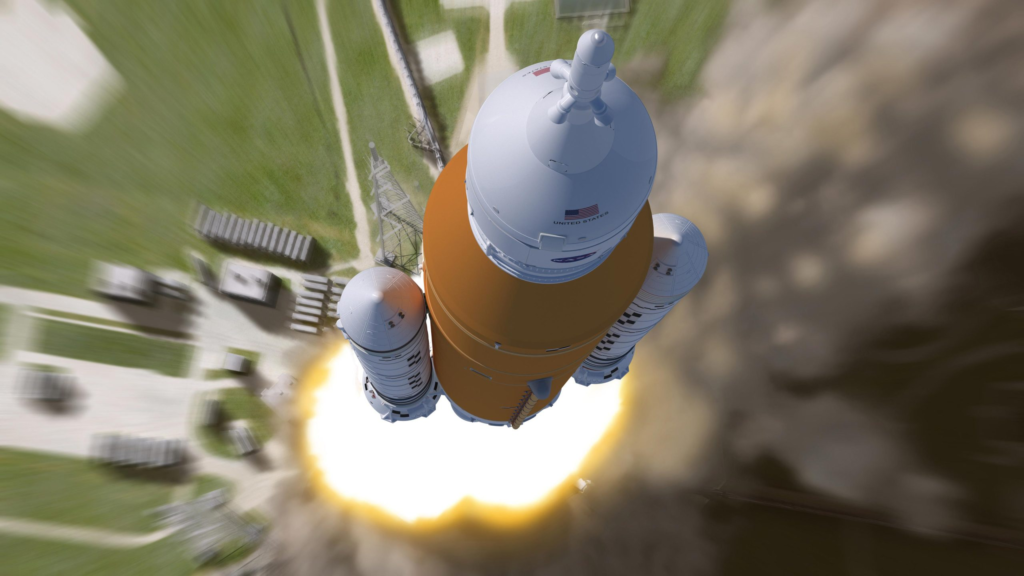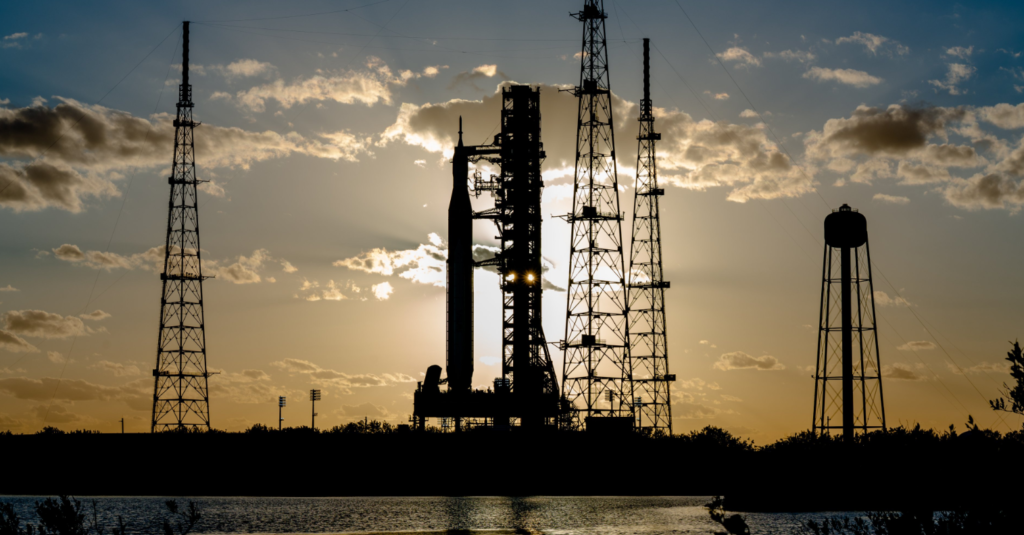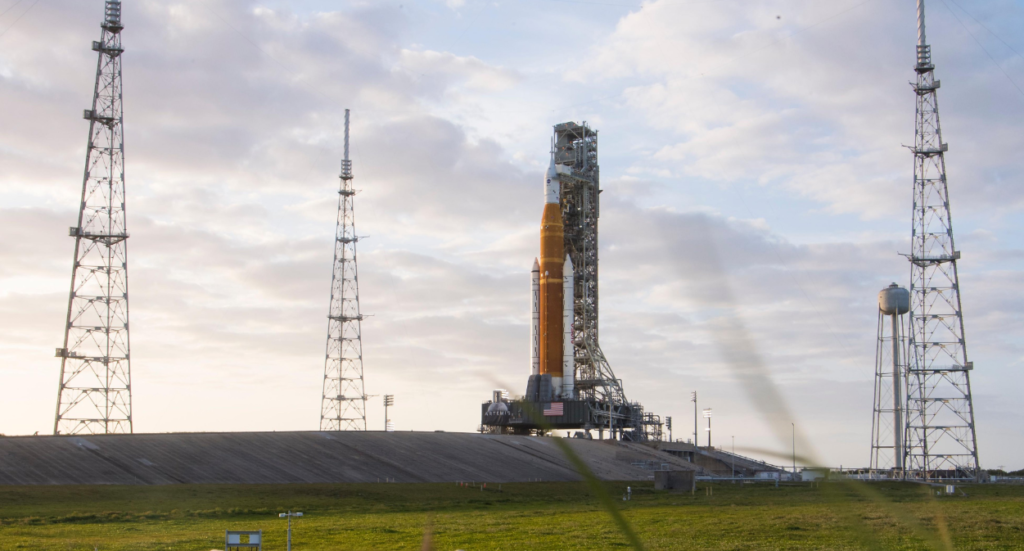
NASA Is Still Trying To Finish SLS’s Wet Dress Rehearsal
It has been a long time since NASA attempted the first wet dress rehearsal of the Space Launch System. Since then, multiple months have passed and a host of problems have arisen. All of which have held back the test, and a large number of other tests such as Artemis 1 planned later in the year. Now in the middle of June, the agency is trying to finish the test successfully.
Specifically, the Space Launch System was recently rolled back to the pad after receiving multiple repairs to the rocket and ground systems. Here it sat in the Vehicle Assembly building while everything was fixed. The agency is confident that they will test the rocket soon and this time it will go according to plan. However, we will have to wait and see if this is the case or not.
The Space Launch System is one of the most powerful rockets ever built, unfortunately, we are yet to see it launch due to what seems like constant delays and different issues. What was originally meant to be a multiple day test is still in progress months later. Here I will go more in-depth into some of the problems this system has been facing, what NASA is working on now, and what to expect in the near future.
Recent Updates

Over the past few days, NASA has been trying to begin and complete the wet dress rehearsal. This began on June 17th when the agency provided an update that suggested that they were on track to begin the approximately two-day wet dress rehearsal for the agency’s Artemis I mission. The test will begin at approximately 5 p.m. EDT June 18 with “call to stations,” when the launch team arrives at their consoles inside the Launch Control Center at NASA’s Kennedy Space Center in Florida. The rehearsal will run the Artemis I launch team through operations to load propellant into the rocket’s tanks, conduct a full launch countdown, demonstrate the ability to recycle the countdown clock, and also drain the tanks to give them an opportunity to practice the timelines and procedures they will use for launch.
During the test, the timing for some events on account of several planned operational demonstrations tied to specific capabilities and test objectives may differ from the day of launch countdown. These demonstrations include tests on the cryogenic systems and an approximately three-minute hold inside the terminal count, which would not normally occur on launch day. If needed, the test team may also hold as necessary to verify conditions before resuming the countdown, or use the test window or extend beyond it, if consumables and resources allow them to complete test objectives.
The next day at approximately 5 p.m. EDT, the launch team arrived at their stations inside the Launch Control Center at NASA’s Kennedy Space Center in Florida to begin the wet dress rehearsal test for NASA’s Artemis I mission. The countdown began 30 minutes later at 5:30 p.m. or L-45 hours, 10 minutes before the initial target T-0 of 2:40 p.m. on Monday, June 20. Overnight, teams will power up the Orion spacecraft and the Space Launch System core stage and prepare the rocket’s four RS-25 engines, which will not be lit during the test. Weather constraints for propellant loading operations planned for Monday stipulate there must be less than a 20% chance of lightning within 5 nautical miles of pad during the first hour of tanking. Winds also must not be above 37.5 knots and the temperature cannot be below 41 degrees Fahrenheit. They also pointed out that activity at the launch pad will likely not be visible during the majority of the countdown, but some venting may be seen during propellant loading.
As of today, the launch team is making its way through countdown operations and NASA says wet dress rehearsal activities remain on track. The mission management team will meet this afternoon to review the status of operations. Overnight, engineers powered up the Orion spacecraft and the Space Launch System’s core stage. Teams also configured several systems on the ground, rocket, and spacecraft and performed activities to prepare umbilicals that connect the rocket and spacecraft to the mobile launcher and are used to provide power, communications, coolant, and propellant. This means tomorrow almost everything is ready for the agency to begin tanking operations. Only hours ago NASA tweeted saying, “Countdown is progressing for #Artemis I wet dress rehearsal. Overnight, teams powered up the @NASA_Orion spacecraft and @NASA_SLS core stage, which will be loaded with more than 700,000 gallons of cryogenic propellant during the tanking phase of countdown.” Now we will have to wait and hope this attempt goes better than the previous.
SLS Complications

Over the past few months of testing, the Space Launch System has had a host of issues arise. The wet dress rehearsal is intended to run the Artemis I launch team through operations to load propellant into the rocket’s tanks, conduct a full launch countdown, demonstrate the ability to recycle the countdown clock, and also drain the tanks to give them an opportunity to practice the timelines and procedures they will use for launch. What was intended to be a multiple day test has been extended months from April to the middle of June. The main reason for this is the repairs and problems that the previous tests revealed. This began with a liquid hydrogen system leak that stopped the initial wet dress rehearsal back in the middle of April. These umbilicals provide liquid oxygen and liquid hydrogen propellants, as well as electrical connections, from the mobile launcher to the rocket’s core stage during the launch countdown. NASA initially conducted leak checks on all the joints and tightened several flange bolts, or fasteners that act as a washer to increase the compression strength, that can loosen over time and were the most likely source of the leak. The agency also re-tightened the flange bolts on the liquid hydrogen, liquid oxygen, and core stage intertank umbilical.
Only a few days before the previous error was found, NASA pointed out that Engineers had identified a helium check valve that was not functioning as expected, requiring these changes to ensure safety of the flight hardware. Helium is used for several different operations, including purging the engine, or clearing the lines, prior to loading propellants during tanking, as well as draining propellant. A check valve is a type of valve that allows liquid or gas to flow in a particular direction and prevents backflow. The helium check valve is about three inches long and prevents the helium from flowing back out of the rocket.
Back in May, after re-tightening the flange bolts on the tail service mast umbilical lines to address a hydrogen leak identified during the previous wet dress rehearsal, engineers determined the seals on the bolts are no longer relaxing, and the system should remain tightly sealed during propellant loading. As a precaution, teams also moved the location of a heavy cantilevered filter on the tail service mast umbilical, which filters out any contaminants in the gaseous helium – a purge gas – that travels through the drain assist purge line. Engineers did not identify any leaks at its previous location, but relocating the filter will ensure it does not contribute to future leaks. Engineers conducted additional leak checks and have not detected any leaks at ambient air temperature. In addition, after replacing the helium check valve on the interim cryogenic propulsion stage (ICPS), engineers found a damaged rubber O-ring seal in the flight side of the quick disconnect – the area that separates the ICPS from the mobile launcher during launch. The O-ring came loose and entered the valve, preventing the valve from sealing correctly. Teams removed the flight and ground side of the quick disconnect system and replaced support hardware that was downstream of the check valve. Work is underway to determine the root cause to prevent any recurrences. Next, teams will re-pressurize the system and test the replaced hardware on the upper stage.
Most recently, the rocket has been inside the Vehicle Assembly Building working on all these different issues. Specifically, teams completed several major objectives, including assessing the liquid hydrogen system leak at the tail service mast umbilical, replacing the interim cryogenic propulsion stage (ICPS) gaseous helium system check valve and support hardware, and modifying the ICPS umbilical purge boots. The addition of hazardous gas detectors above the upper stage allows for additional visibility into any potential leaks during cryogenic operations. All of which will be put to the test in only a few days as NASA is expected to start tanking on the launch vehicle not long from now.
Conclusion
The Space Launch System has not had the smoothest progression over the past few years. In recent months especially, the launch system has run into a host of issues revealed by the wet dress rehearsal attempts. These delays have pushed back important future launches such as Artemis 1, and in the grand scheme of things, returning humans to the Moon. We will have to wait and see how it progresses and the impact it has on the space industry.
